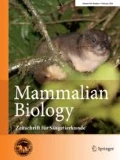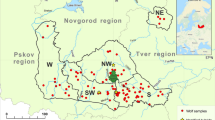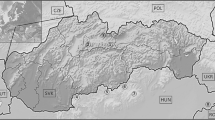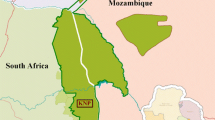Abstract
Despite the known genetic permeability among wolf-like canids, there is currently no evidence of gene flow between the recently acknowledged African wolf (Canis lupaster) and domestic dogs (C. lupus familiaris). We genotyped African wolves across their range, together with African domestic dogs and ‘reference’ grey wolves (C. l. lupus; not occurring in Africa). Northwestern African wolves showed (1) the greatest genetic diversity as observed from microsatellite loci and mitochondrial + Y-chromosome markers, and (2) possible signs of past admixture with grey wolves. We detected two zones of hybridization between domestic dogs and African wolves, in northwestern Senegal and central Ethiopia. Hybrids were intermediary in the nuclear genetic space separating African wolves from domestic dogs (and grey wolves), and were in majority assigned to domestic dogs in STRUCTURE. Hybrids showed mitochondrial DNA haplotypes of African wolves, suggesting gene flow directionality between male African dogs and female African wolves. The roaming of feral and shepherds’ dogs in degraded habitats occupied by African wolves may have promoted hybridization. Our results provide evidence that, subsequent to the possible hybrid origin of C. lupaster, the genome of the African wolf is still subject to admixture with C. lupus descendants. This could lead to the genetic dilution of endemic African wolf lineages, such as in eastern Africa, but may also imply disease prevalence and competition for resources with domestic dogs. Our study also is the first to show a significant level of differentiation (ΦST and FST) between North African and West African wolves. Wider genetic screening of African wolves across their range should depict more accurately their population dynamics and the potential stakes related to gene flow with domestic dogs.





Similar content being viewed by others
Availability of data and material
The new sequences have been deposited in GenBank.
Code availability
Not applicable.
References
Adams JR, Waits LP (2007) An efficient method for screening faecal DNA genotypes and detecting new individuals and hybrids in the red wolf (Canis rufus) experimental population area. Cons Genet 8:123–131
Allendorf FW, Leary RF, Spruell P, Wenburg JK (2001) The problems with hybrids: setting conservation guidelines. TREE 16:613–622
Amroun M, Oubellil D, Gaubert P (2014) Ecologie trophique du Chacal doré dans le Parc National du Djurdjura (Kabylie, Algérie). Terre et Vie 69:304–317
Anderson TM, vonHoldt BM, Candille SI, Musiani M, Greco C, Stahler DR, Smith DW, Padhukasahasram B, Randi E, Leonard JA, Bustamante CD, Ostrander EA, Tang H, Wayne RK, Barsh GS (2009) Molecular and evolutionary history of melanism in North American gray wolves. Science 323:1339–1343
Ardalan A, Kluetsch CFC, Zhang A-B, Erdogan M, Uhlén M, Houshmand M, Tepeli C, Ashtiani SRM, Savolainen P (2011) Comprehensive study of mtDNA among Southwest Asian dogs contradicts independent domestication of wolf, but implies dog–wolf hybridization. Ecol Evol 1:373–385
Atickem A, Williams S, Bekele A, Thirgood S (2010) Livestock predation in the Bale Mountains, Ethiopia. Afr J Ecol 48:1076–1082
Bannasch DL, Bannasch MJ, Ryun JR, Famula TR, Pedersen NC (2005) Y chromosome haplotype analysis in purebred dogs. Mamm Genome 16:273–280
Benoit M (1984) Le Séno-Mango ne doit pas mourir. Editions de l'Office de la Recherche Scientifique et Technique Outre-Mer, Paris
Blanco JC, Cortés Y (2007) Dispersal patterns, social structure and mortality of wolves living in agricultural habitats in Spain. J Zool 273:114–124
Bohling JH, Waits LP (2011) Assessing the prevalence of hybridization between sympatric Canis species surrounding the red wolf (Canis rufus) recovery area in North Carolina. Mol Ecol 20:2142–2156
DeCandia A, Gaughran S, Caragiulo A, Amato G (2016) A novel molecular method for noninvasive sex identification of order Carnivora. Conserv Genet Resour 8:119–121
Doyle J (1991) DNA protocols for plants. In: Hewitt GM, Johnston AWB, Young JPW (eds) Molecular techniques in Taxonomy. Springer, Berlin, pp 283–293
Earl DA, VonHoldt BM (2012) STRUCTURE HARVESTER: a website and program for visualizing STRUCTURE output and implementing the Evanno method. Conserv Genet Resour 4:359–361
Eddine A, Rocha RG, Mostefai N, Karssene Y, Smet KD, Brito JC, Klees D, Nowak C, Cocchiararo B, Lopes S, Leer PVD, Godinho R (2020) Demographic expansion of an African opportunistic carnivore during the Neolithic revolution. Biol Lett 16:20190560
Evanno G, Regnaut S, Goudet J (2005) Detecting the number of clusters of individuals using the software structure: a simulation study. Mol Ecol Not 14:2611–2620
Excoffier L, Lischer H (2015) Arlequin ver. 3.5. 2: an integrated software package for population genetics data analysis. Institute of Ecology and Evolution, University of Berne, Switzerland
Felsenstein J (1985) Confidence limits on phylogenies: an approach using the bootstrap. Evolution 39:783–791
Ferguson WW (1981) The systematic position of Canis aureus lupaster (Carnivora: Canidae) and the occurrence of Canis lupus in North Africa, Egypt and Sinai. Mammalia 45:459–466
Ferrando A, Lecis R, Domingo-Roura X, Ponsà M (2008) Genetic diversity and individual identification of reintroduced otters (Lutra lutra) in north-eastern Spain by DNA genotyping of spraints. Cons Biol 9:129–139
Galov A, Fabbri E, Caniglia R, Arbanasić H, Lapalombella S, Florijančić T, Bošković I, Galaverni M, Randi E (2015) First evidence of hybridization between golden jackal (Canis aureus) and domestic dog (Canis familiaris) as revealed by genetic markers. R Soc Open Sci 2:150450
García-Moreno J, Matocq MD, Roy MS, Geffen E, Wayne RK (1996) Relationships and genetic purity of the endangered Mexican wolf based on analysis of microsatellite loci. Cons Biol 10:376–389
Gaubert P, Bloch C, Benyacoub S, Abdelhamid A, Pagani P, Djagoun CA, Couloux A, Dufour S (2012) Reviving the African wolf Canis lupus lupaster in North and West Africa: a mitochondrial lineage ranging more than 6,000 km wide. PLoS ONE 7:e42740
Gaubert P, Patel RP, Veron G, Goodman SM, Willsch M, Vasconcelos R, Lourenço A, Sigaud M, Justy F, Joshi BD, Fickel J, Wilting A (2017) Phylogeography of the small Indian civet and origin of introductions to western Indian Ocean islands. J Hered 108:270–279
Geffen E, Anderson MJ, Wayne RK (2004) Climate and habitat barriers to dispersal in the highly mobile grey wolf. Mol Ecol 13:2481–2490
Gese EM, Knowlton FF, Adams JR, Beck K, Fuller TK, Murray DL, Steury TD, Stoskopf MK, Waddell WT, Waits LP (2015) Managing hybridization of a recovering endangered species: the red wolf Canis rufus as a case study. Curr Zool 61:191–205
Godinho R, Llaneza L, Blanco JC, Lopes S, Alvares F, GarcÍA EJ, Palacios V, Cortés Y, Talegon J, Ferrand N (2011) Genetic evidence for multiple events of hybridization between wolves and domestic dogs in the Iberian Peninsula. Mol Ecol 20:5154–5166
Gopalakrishnan S, Sinding M-HS, Ramos-Madrigal J, Niemann J, Samaniego Castruita JA, Vieira FG, Carøe C, Montero MDM, Kuderna L, Serres A, González-Basallote VM, Liu Y-H, Wang G-D, Marques-Bonet T, Mirarab S, Fernandes C, Gaubert P, Koepfli K-P, Budd J, Rueness EK, Heide-Jørgensen MP, Petersen B, Sicheritz-Ponten T, Bachmann L, Wiig Ø, Hansen AJ, Gilbert MTP (2018) Interspecific gene flow shaped the evolution of the genus Canis. Curr Biol 28:3441–3449
Gottelli D, Sillero-Zubiri C, Applebaum GD, Roy MS, Girman DJ, Garcia-Moreno J, Ostrander EA, Wayne RK (1994) Molecular genetics of the most endangered canid: the Ethiopian wolf Canis simensis. Mol Ecol 3:301–312
Goudet J (2001) FSTAT, version 2.9.3. A program to estimate and test gene diversities and fixation indices. Lausanne University, Lausanne, Switzerland. https://www2.unil.ch/popgen/softwares/fstat.htm.
Gray AP (1954) Mammalian hybrids—a check-list with bibliography. Commonwealth Agricultural Bureaux, Bucks
Green JS, Gipson PS (1994) Feral dogs, the handbook: prevention and control of wildlife damage. pp C77–C81. https://digitalcommons.unl.edu/icwdmhandbook/35
Guo SW, Thompson EA (1992) Performing the exact tests of Hardy–Weinberg proportion for multiple alleles. Biometrics 48:361–372
Gutema TM, Atickem A, Tsegaye D, Bekele A, Sillero-Zubiri C, Marino J, Kasso M, Venkataraman VV, Fashing PJ, Stenseth NC (2019) Foraging ecology of African wolves (Canis lupaster) and its implications for the conservation of Ethiopian wolves (Canis simensis). R Soc Open Sci 6:190772
Hailer F, Leonard JA (2008) Hybridization among three native North American Canis species in a region of natural sympatry. PLoS ONE 3:e3333
Hall TA (1999) BioEdit: a user-friendly biological sequence alignment and analysis program for Windows 95/98/NT. Nucleic Acids Symp Ser 41:95–98
Heppenheimer E, Harrigan RJ, Rutledge LY, Koepfli K-P, DeCandia AL, Brzeski KE, Benson JF, Wheeldon T, Patterson BR, Kays R, Hohenlohe PA, Von Holdt BM (2018) Population genomic analysis of North American Eastern wolves (Canis lycaon) supports their conservation priority status. Genes 9:606
Hindrikson M, Männil P, Ozolins J, Krzywinski A, Saarma U (2012) Bucking the trend in wolf-dog hybridization: first evidence from Europe of hybridization between female dogs and male wolves. PLoS ONE 7:e46465
Hubisz MJ, Falush D, Stephens M, Pritchard JK (2009) Inferring weak population structure with the assistance of sample group information. Mol Ecol Res 9:1322–1332
Iacolina L, Scandura M, Gazzola A, Cappai N, Capitani C, Mattioli L, Vercillo F, Apollonio M (2010) Y-chromosome microsatellite variation in Italian wolves: a contribution to the study of wolf-dog hybridization patterns. Mamm Biol 75:341–347
Kalinowski ST (2005) HP-RARE 1.0: a computer program for performing rarefaction on measures of allelic richness. Mol Ecol Not 5:187–189
Karssene Y, Chammem M, Nowak C, de Smet K, Castro D, Eddine A, Lopes S, Muñoz-Fuentes V, Cocchiararo B, Klees D, Van Der Leer P, Nouira S, Godinho R (2018) Noninvasive genetic assessment provides evidence of extensive gene flow and possible high movement ability in the African golden wolf. Mamm Biol 92:94–101
Kays R, Curtis A, Kirchman JJ (2010) Rapid adaptive evolution of northeastern coyotes via hybridization with wolves. Biol Lett 6:89–93
Klütsch CFC, Seppälä EH, Fall T, Uhlén M, Hedhammar Å, Lohi H, Savolainen P (2011) Regional occurrence, high frequency but low diversity of mitochondrial DNA haplogroup d1 suggests a recent dog-wolf hybridization in Scandinavia. Anim Genet 42:100–103
Koepfli K-P, Pollinger J, Godinho R, Robinson J, Lea A, Hendricks S, Schweizer RM, Thalmann O, Silva P, Fan Z, Yurchenko AA, Dobrynin P, Makunin A, Cahill JA, Shapiro B, Álvares F, Brito JC, Geffen E, Leonard JA, Helgen KM, Johnson WE, O’Brien SJ, Van Valkenburgh B, Wayne RK (2015) Genome-wide evidence reveals that African and Eurasian golden jackals are distinct species. Curr Biol 25:2158–2165
Kumar S, Stecher G, Li M, Knyaz C, Tamura K (2018) MEGA X: molecular evolutionary genetics analysis across computing platforms. Mol Biol Evol 35:1547–1549
Lahmar S, Boufana BS, Lahmar S, Inoubli S, Guadraoui M, Dhibi M, Bradshaw H, Craig PS (2009) Echinococcus in the wild carnivores and stray dogs of northern Tunisia: the results of a pilot survey. Ann Trop Med Parasitol 103:323–331
Lehman N, Eisenhawer A, Hansen K, Mech LD, Peterson R, Gogan PJP, Wayne RK (1991) Introgression of coyote mitochondrial DNA into sympatric North American gray wolf populations. Evolution 45:104–119
Leroy G (2011) Genetic diversity, inbreeding and breeding practices in dogs: results from pedigree analyses. Vet J 189:177–182
Librado P, Rozas J (2009) DnaSP v5: a software for comprehensive analysis of DNA polymorphism data. Bioinf 25:1451–1452
Liu Y-H, Wang L, Xu T, Guo X, Li Y, Yin T-T, Yang H-C, Yang H, Adeola AC, Sanke OJ, Otecko NO, Wang M, Ma Y, Charles OS, Sinding M-HS, Gopalakrishnan S, Samaniego JA, Hansen AJ, Fernandes C, Gaubert P, Budd J, Dawuda PM, Rueness EK, Jiang L, Zhai W, Gilbert MTP, Peng M-S, Qi X, Wang G-D, Zhang Y-P (2017) Whole-genome sequencing of African dogs provides insights into adaptations against tropical parasites. Mol Biol Evol 35:287–298
Matallah S, Abbas K, Bouju S (2015) Le rôle clé du gardiennage des troupeaux dans la gestion durable des ressources pastorales du Nord-Est algérien. Les Cahiers d'Outre Mer 271:349–373
Mengel RM (1971) A study of dog-coyote hybrids and implications concerning hybridization in Canis. J Mamm 52:316–336
Montana L, Caniglia R, Galaverni M, Fabbri E, Ahmed A, Bolfíková BČ, Czarnomska SD, Galov A, Godinho R, Hindrikson M, Hulva P, Jędrzejewska B, Jelenčič M, Kutal M, Saarma U, Skrbinšek T, Randi E (2017) Combining phylogenetic and demographic inferences to assess the origin of the genetic diversity in an isolated wolf population. PLoS ONE 12:e0176560–e0176560
Monzón J, Kays R, Dykhuizen DE (2014) Assessment of coyote–wolf–dog admixture using ancestry-informative diagnostic SNPs. Mol Ecol 23:182–197
Nassef M (2003) The ecology and evolution of the golden jackal (Canis aureus): investigating a cryptic species. University of Leeds, Leeds
Ostrander EA, Sprague GF, Rine J (1993) Identification and characterization of dinucleotide repeat (CA)n markers for genetic mapping in dog. Genomics 16:207–213
Ostrander EA, Mapa FA, Yee M, Rine J (1995) One hundred and one new simple sequence repeat-based markers for the canine genome. Mamm Genome 6:192–195
Pacheco C, López-Bao JV, García EJ, Lema FJ, Llaneza L, Palacios V, Godinho R (2017) Spatial assessment of wolf-dog hybridization in a single breeding period. Sci Rep 7:42475
Peakall R, Smouse PE (2006) GENALEX 6: genetic analysis in Excel. Population genetic software for teaching and research. Mol Ecol Not 6:288–295
Pilot M, Greco C, vonHoldt BM, Randi E, Jędrzejewski W, Sidorovich VE, Konopiński MK, Ostrander EA, Wayne RK (2018) Widespread, long-term admixture between grey wolves and domestic dogs across Eurasia and its implications for the conservation status of hybrids. Evol Appl 11:662–680
Polzin T, Daneshmand SV (2008) Network 4.5.1.0. User guide, date: 27 December 2008 ed. Fluxus Technology, Clare
Prager KC, Mazet JAK, Dubovi EJ, Frank LG, Munson L, Wagner AP, Woodroffe R (2012) Rabies virus and canine distemper virus in wild and domestic carnivores in northern Kenya: are domestic dogs the reservoir? EcoHealth 9:483–498
Pritchard JK (2010) Documentation for structure software: version 2.3. Department of Human Genetics, Chicago
Pritchard JK, Stephens M, Donnelly P (2000) Inference of population structure using multilocus genotype data. Genetics 155:945–959
Randi E (2011) Genetics and conservation of wolves Canis lupus in Europe. Mamm Rev 41:99–111
Randi E, Hulva P, Fabbri E, Galaverni M, Galov A, Kusak J, Bigi D, Bolfíková BČ, Smetanová M, Caniglia R (2014) Multilocus detection of wolf x dog hybridization in Italy, and guidelines for marker selection. PLoS ONE 9:e86409
Raymond M, Rousset F (1995) An exact test for population differentiation. Evolution 49:1280–1283
Rousset F (2017) Genepop version 4.7.0. Institut des Sciences de l'Evolution de Montpellier, Université de Montpellier, France
Roy MS, Geffen E, Smith D, Ostrander EA, Wayne RK (1994) Patterns of differentiation and hybridization in North American wolflike canids, revealed by analysis of microsatellite loci. Mol Biol Evol 11(4):553–570
Rueness EK, Asmyhr MG, Sillero-Zubiri C, Macdonald DW, Bekele A, Atickem A, Stenseth NC (2011) The cryptic African wolf: Canis aureus lupaster is not a golden jackal and is not endemic to Egypt. PLoS ONE 6:e16385
Rueness EK, Trosvik P, Atickem A, Sillero-Zubiri C, Trucchi E (2015) The African wolf is a missing link in the wolf-like canid phylogeny. bioRxiv, 017996
Saleh M, Younes M, Sarhan M, Abdel-Hamid F (2018) Melanism and coat colour polymorphism in the Egyptian Wolf Canis lupaster Hemprich & Ehrenberg (Carnivora: Canidae) from Egypt. Zool Middle East 64:1–12
Schwarz G (1978) Estimating the dimension of a model. Ann Stat 6:461–464
Smouse PE, Peakall R (1999) Spatial autocorrelation analysis of individual multiallele and multilocus genetic structure. Heredity 82:561–573
Sundqvist AK, Ellegren H, Olivier M, Vilà C (2001) Y chromosome haplotyping in Scandinavian wolves (Canis lupus) based on microsatellite markers. Mol Ecol 10:1959–1966
Taberlet P, Griffin S, Goossens B, Questiau S, Manceau V, Escaravage N, Waits LP, Bouvet J (1996) Reliable genotyping of samples with very low DNA quantities using PCR. Nucl Acids Res 24:3189–3194
Toonen RJ, Shayne H (2001) Increased throughput for fragment analysis on an ABI PRISM® 377 automated sequencer using a membrane comb and STRand software. Biotechniques 31:1320–1324
Van Oosterhout C, Hutchinson WF, Wills DPM, Shipley P (2004) Micro-checker: software for identifying and correcting genotyping errors in microsatellite data. Mol Ecol Not 4:535–538
Vanak AT, Gompper ME (2009) Dogs Canis familiaris as carnivores: their role and function in intraguild competition. Mamm Rev 39:265–283
Verhoeven KJF, Simonsen KL, McIntyre LM (2005) Implementing false discovery rate control: increasing your power. Oikos 108:643–647
Vila C, Walker C, Sundqvist A-K, Flagstad O, Andersone Z, Casulli A, Kojola I, Valdmann H, Halverson J, Ellegren H (2003) Combined use of maternal, paternal and bi-parental genetic markers for the identification of wolf-dog hybrids. Heredity 90:17–24
Vilà C, Wayne RK (1999) Hybridization between wolves and dogs. Cons Biol 13:195–198
Viranta S, Atickem A, Werdelin L, Stenseth NC (2017) Rediscovering a forgotten canid species. BMC Zool 2:6
vonHoldt BM, Aardema ML (2020) Updating the bibliography of interbreeding among Canis in North America. J Hered 111:249–262
vonHoldt BM, Pollinger JP, Lohmueller KE, Han E, Parker HG, Quignon P, Degenhardt JD, Boyko AR, Earl DA, Auton A, Reynolds A, Bryc K, Brisbin A, Knowles JC, Mosher DS, Spady TC, Elkahloun A, Geffen E, Pilot M, Jedrzejewski W, Greco C, Randi E, Bannasch D, Wilton A, Shearman J, Musiani M, Cargill M, Jones PG, Qian Z, Huang W, Ding Z-L, Zhang Y-P, Bustamante CD, Ostrander EA, Novembre J, Wayne RK (2010) Genome-wide SNP and haplotype analyses reveal a rich history underlying dog domestication. Nature 464:898–902
vonHoldt BM, Cahill JA, Fan Z, Gronau I, Robinson J, Pollinger JP, Shapiro B, Wall J, Wayne RK (2016) Whole-genome sequence analysis shows that two endemic species of North American wolf are admixtures of the coyote and gray wolf. Sci Adv 2:e1501714
Wayne RK, Jenks SM (1991) Mitochondrial DNA analysis implying extensive hybridization of the endangered red wolf Canis rufus. Nature 351:565–568
Weir BS, Cockerham CC (1984) Estimating F-statistics for the analysis of population structure. Evolution 38:1358–1370
Woodroffe R, Prager KC, Munson L, Conrad PA, Dubovi EJ, Mazet JAK (2012) Contact with domestic dogs increases pathogen exposure in endangered African wild dogs (Lycaon pictus). PLoS ONE 7:e30099–e30099
Irwin DM, Kocher TD, Wilson AC (1991) Evolution of the cytochrome b gene of mammals. J Mol Evol 32:128-144
Kocher TD, Thomas WK, Meyer A, Edwards SV, Paabo S, Villablanca FX, Wilson AC (1989) Dynamics of mitochondrial DNA evolution in animals: amplification and sequencing with conserved primers. Proc Natl Acad Sci USA 86:6196-6200
Palomares F, Godoy JA, Piriz A, O'Brien SJ (2002) Faecal genetic analysis to determine the presence and distribution of elusive carnivores: design and feasibility for the Iberian lynx. Mol Ecol 11:2171-2182
Acknowledgements
We thank the following persons for participating in the sampling effort: K. Difallah (Setif, Algeria), S. Benyacoub (Station Biologique d’El Mellah, Université d'Annaba, Algeria), A. Abdelhamid (Saint Katherine Protectorate, Nature Conservation Sector, Egyptian Environmental Affairs Agency, Egypt), C.A.M.S. Djagoun (Université d’Abomey-Calavi, Cotonou, Benin), N. Lescureux (Muséum National d’Histoire Naturelle de Paris, France), and G. Dobigny (Centre de Biologie pour la Gestion des Populations, Montpellier, France). Laboratory work at ISEM was conducted on the GenSeq platform of LabEx CeMEB (Centre Méditerranéen Environnement et Biodiversité). We thank the staff of the Service de Systématique Moléculaire, Muséum National d’Histoire Naturelle de Paris, for their assistance during the early phases of the project and related laboratory work. M. Balastre helped with the graphical design of the figures. Two reviewers provided helpful comments on an early draft of the manuscript.
Funding
PG and TT were partly supported by the Action Transversale Muséum ‘Biodiversité actuelle et fossile’, MNHN Paris. KM and PG received support from ‘Soutien aux missions de développement au Sud’, IRD/ISEM Montpellier. KM was funded by the program ‘Stages de perfectionnement en France’, Université de Tizi-Ouzou, Algeria.
Author information
Authors and Affiliations
Contributions
PG, EKR and MA designed the study. KM, SD, EKR, CB, MA and PG collected the genetic samples. KM, FJ, TT and PG did the laboratory work. KM, FJ and PG conducted data treatment and analysis. CB and JB photographed the phenotypes. All the co-authors participated in the writing of the manuscript.
Corresponding authors
Ethics declarations
Conflict of interest
The authors declare that they have no conflict of interest.
Ethics approval
Not applicable.
Consent to participate
Not applicable.
Consent for publication
All co-authors confirm their consent for the publication of the present study.
Additional information
Handling editor: Laura Iacolina.
Publisher's Note
Springer Nature remains neutral with regard to jurisdictional claims in published maps and institutional affiliations.
Electronic supplementary material
Below is the link to the electronic supplementary material.
42991_2020_59_MOESM1_ESM.eps
Supplementary file1 Figure S1. Midpoint rooted maximum likelihood phylogenetic tree of African wolves, grey wolves and African domestic dogs based on 402 bp cytochrome b sequences (cytb1; A) and 297 bp control region sequences (CR1; B). Values at nodes correspond to bootstrap support > 75 %. Bars indicate 0.5 / 2.0% divergence in A and B, respectively. Sample numbers refer to Table S1. Yellow box = cluster “grey wolves / African domestic dogs”; green box = cluster “African wolves”; orange box = African wolf x African domestic dog hybrid; asterisk = African domestic dog clustering with African wolves. (EPS 831 kb)
42991_2020_59_MOESM2_ESM.psd
Supplementary file2 Figure S2. Midpoint rooted maximum likelihood phylogenetic trees of African wolves, grey wolves and African domestic dogs based on 158 bp cytochrome b sequences (cytb2; A) and 126 bp control region sequences (CR2; B). Values at nodes correspond to bootstrap support > 75 %. Bars indicate 0.5 / 1.0% divergence in A and B, respectively. Sample numbers refer to Table S1. Yellow box = cluster “grey wolves / African domestic dogs”; green box = cluster “African wolves”; orange box = African wolf x African domestic dog hybrid; asterisk = African domestic dog clustering with African wolves. (PSD 785 kb)
42991_2020_59_MOESM3_ESM.eps
Supplementary file3 Figure S3. Distribution of Y-chromosome haplotypes among African wolves (Algeria, Senegal), grey wolves and African domestic dogs. (EPS 1480 kb)
42991_2020_59_MOESM4_ESM.psd
Supplementary file4 Figure S4. Plots of the probabilistic assignments inferred in STRUCTURE among individuals of African wolves, African domestic dogs, grey wolves and their hybrids, using autosomal loci. Each individual is represented by a vertical bar. K varies from 2 to 8. (PSD 17356 kb)
42991_2020_59_MOESM5_ESM.eps
Supplementary file5 Figure S5. Optimal K values derived from the analysis with STRUCTURE of the combined dataset (autosomal + Y-chromosome loci; A) and the autosomal loci alone (B), figured as ΔK (left) and Ln Pr(X|K) (right) plots. (EPS 2806 kb)
42991_2020_59_MOESM6_ESM.xlsx
Supplementary file6Table S1. Detailed list of the 62 samples used in this study. Columns for cytochrome b (cytb) and control region (CR) indicate (i) haplotype number (see Fig. 2) and ii) Genbank accession numbers for new haplotypes (after hyphen) and already published haplotypes (between brackets). Cytochrome b and control region haplotypes with haplotype numbers in parenthesis are short fragments that 100% matched with one or several longer fragments. Control region haplotypes without haplotype number correspond to unique, short fragments not figured in Fig. 2 (but figured in Figs S1B and S2B). Taxonomic assignments from mitochondrial DNA (cytb and CR ML trees) and microsatellites (STRUCTURE; K=4) are given in colors: yellow = grey wolf + African domestic dog; green = African wolf; orange = African dog x African wolf hybrid; red = potential grey wolf x African wolf hybrids (see Discussion). (XLSX 20 kb)
42991_2020_59_MOESM8_ESM.docx
Supplementary file 8 Table S3. Mitochondrial diversity among African wolves (Algeria, Senegal and Ethiopia), grey wolves and African domestic dogs. (h) haplotype number, (Hd) haplotype diversity, (π) nucleotide diversity, (k) average number of nucleotide differences. Cytb1-CR1 and cytb2-CR2 correspond to the long and short cytochrome b and control region fragments, respectively. (DOCX 14 kb)
42991_2020_59_MOESM9_ESM.docx
Supplementary file 9 Table S4. Pairwise differentiation (ΦST) among African wolves (Algeria, Senegal, Ethiopia), grey wolves and African domestic dogs. Cytb1 and CR1 correspond to the long cytochrome b and control region fragments, respectively. (DOCX 14 kb)
42991_2020_59_MOESM10_ESM.docx
Supplementary file 10 Table S5. Genetic differentiation (FST) among African wolves (Algeria, Senegal, Ethiopia), grey wolves and African domestic dogs, based on autosomal loci. (EPS 13 kb)
Rights and permissions
About this article
Cite this article
Mallil, K., Justy, F., Rueness, E.K. et al. Population genetics of the African wolf (Canis lupaster) across its range: first evidence of hybridization with domestic dogs in Africa. Mamm Biol 100, 645–658 (2020). https://doi.org/10.1007/s42991-020-00059-1
Received:
Accepted:
Published:
Issue Date:
DOI: https://doi.org/10.1007/s42991-020-00059-1




